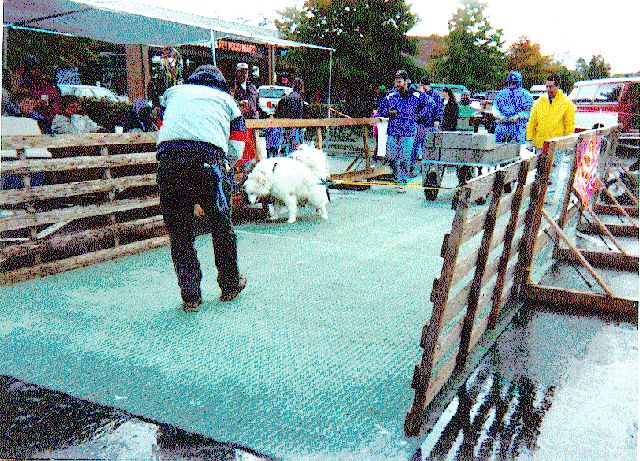 |
|
Home

|
Overview of a Pull
 Sam pulling about 600# at Trout Lake The handler is in the lower left corner behind the 16' finish line. The blue line in front of the sled (right below Sam's tail) is the start line. Since the sled can quickly freeze to the snow, there is a setup line one foot behind the start line (snow pulls only). The sled is set perpendicular to the setup line and anywhere along it of the handler's choosing (the track may be rough in places). Sam and handler are positioned behind the sled and marshals. When both ready, the sled is moved to the start line and they then come forward and Sam is hooked to the tow line (this 1' move unsticks the sled and gives everyone similar setup time in case it sticks again). Sam must stay, and the handler progresses behind the finish line. The handler then commands Sam to pull (the clock starts). The handler can use any voice and signaling commands to call Sam toward him; but cannot use any treats or implements to coerce Sam to pull. The handler must stay behind the line at all times. As Sam approaches the line, the handler cannot touch him. He has one minute to get the front of the sled across the finish line, else he is disqualified. A wheel pull with a cart would be identical, but there is no setup line. On wheels on a smooth surface, the dogs tend to pull three to five times as much weight.
 Sam pulling in the rain at Puyallup, WA The above is one pull out of several (nominally 5 - 12) that Sam would do for the day's competition. The sled/cart is started with some minimal weight. All dogs within a weight class pull this starting weight. An agreed upon weight increment is added, and all dogs pull again. There is an exception in that a handler may elect to skip one or two weights but no more than two as strategy or to conserve their dog's energy. This increment and everyone pulling continues, and at each weight one or more dogs may fail to pull. This continues until only one dog (or none) succeeds in pulling the current weight. The dog pulling the most is first, next most is second, etc. Ties are broken by the dog that pulls the weight the fastest. The above is just one weight class. There are nine: 0-10, 11-25, 26-40, 41-60, 61-80, 81-100, 101-125, 126-150, 151 and over. So the above is repeated for each weight class. Sometimes, there are very few dogs within a particular weight class, and classes will be combined. Even with this, the dogs still compete with only their weigh class. The pulling surface may be cleaned-up and graded between classes, but not during a class. And that is a weight pull event. It nominally takes 3 to 5 hours, depending on the number of dogs. We usually have the events on weekends (but not limited to weekends) and usually have two events (one on Saturday, and one on Sunday). But each day is separate and you need not attend both. Since participants often travel 100 - 300 miles, the Saturday event usually starts late morning, and the Sunday event mid morning.
Atmosphere
Enjoyment and/or competition. You get to do things with your dog; it is good exercise for your dog; you have an excuse to travel; you get to meet a lot of interesting people. And, you can earn achievement awards; sometimes there are prizes (maybe 40# dog food); and you compete against all dogs in your weight class in your region. At the end of the season, there is a National Championship where the top dogs of each weight class compete across regions. During the season, member dogs (owned by a member and handled by a member) earn points. First in their weight at an event gets 5 points, plus one for each dog beat. second gets 3, plus one for each dog beat. third gets 1, plus one for each dog beat. All remaining dogs that made at least one successful pull get 1 for each dog beat; and last place gets ½ point. Dogs not making a successful pull get no points, but they are counted as dogs beat. Provisional dogs (not owned by a member and pulled by a member) earn no point, but contribute points. However, they do hold a lineup position and are eligible for any prizes at the pull. During the season, your top five scores are added to get your final score. However, if you go out of your region for pulls, only two of those are allowed in your top five. All breeds (even mixed) may compete. Most common are the malamutes, huskies, rottweilers and pit bulls; but we have beagles, cockers and mastiffs. Smaller dogs tend to pull a bigger percentage of their weight than the bigger dogs. Pit Bulls (and other terriers) do very well. They get into it and don't know when to quit. On the other hand; the northern breeds are often too independent and stubborn and will elect not to pull long before their capability runs out.
Are you safe around all these dogs? Are the dogs in danger? We have a few very strict rules:
Address further questions about IWPA to:
Melissa Kehler IWPA Championships | Forms | Members Corner | Contact Us | Photo Gallery | Hall of Fame | Links | Classifieds |
International Weight Pull Association |